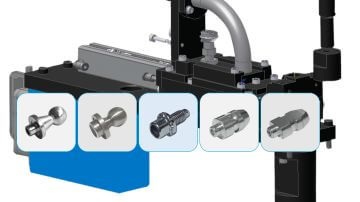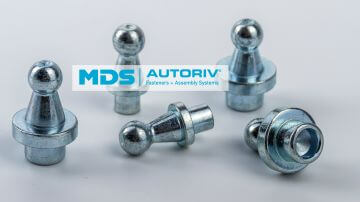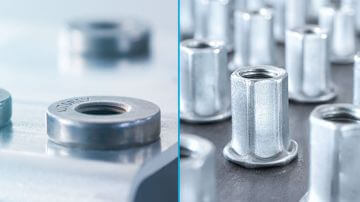
Joining methods for ball studs
Press riveting vs. orbital riveting, welding or screwing
Blog post | january 9, 2023
Every vehicle contains a large number of functional fasteners that contribute significantly to the performance and safety of the vehicle. A good example of this are the ball studs used in hoods, trunks and door hinges. These fasteners are crucial for the proper functioning of the mentioned vehicle components. Due to their high load-bearing capacity and stability, they should work reliably even under extreme conditions. This is why choosing the right joining method for ball studs is of great importance.
Contact us
Our customer service will help you with any questions!
Contents
- Joining methods for connecting ball pins to the body panel
- Press riveting of ball studs is more effective than orbital riveting, welding or screwing
- Possible applications for ball studs
- Advantages of the ball pin rivet
- Cost savings with the rivet ball stud
- Summary

Joining methods for connecting ball studs to the body panel
In the automotive industry, various joining methods are used to connect ball studs to the body panel. These include orbital riveting, resistance welding and screwing. An alternative to this is press riveting, which saves both time and costs and still enables a high load-bearing capacity of the ball stud.
Orbital riveting
Orbital riveting is a joining process in which the ball pin is worked into the body panel by means of a rotating movement. In this process, an orbital riveting tool is placed on the rivet collar of the ball stud and rotated under pressure. The circular or elliptical movement mechanically deforms the rivet collar. The material of the ball pin rivet encloses the sheet metal and forms a permanent bond with the component.
The advantage of orbital riveting is that it does not require any additional auxiliary materials or additives such as adhesives or welding materials. However, this process requires more time and resources than press riveting, as the joining process involves two work steps - inserting the ball stud and riveting.
Welding
Resistance welding is a manufacturing process that uses heat to join components together.
The ball pin is first placed on the body panel. A high electric current is then passed through the fastener and the sheet metal. As the resistance is higher in these areas, the current generates heat, which melts the metal at the contact point. Once the metal has melted, high pressure is applied to fuse the parts together. After cooling, the molten metal forms a solid bond between the ball stud and the sheet metal.
This process is relatively time-consuming and requires a high degree of precision. Welding ball pins is also associated with costs for equipment, electricity and maintenance.
Screwing
Screwing is the most expensive option, as it requires additional work steps and further fasteners, i.e. one nut per ball stud. In this joining process, the ball pin is screwed into the nut, which is already connected to the body panel. The nut is therefore placed on the sheet metal in the first step and connected to the sheet metal either by welding or press riveting. The ball pin is then screwed into the fixed nut, creating a firm and permanent connection between the fastener and the sheet metal.

Press riveting of ball studs is more effective than orbital riveting, welding or screwing
Ball pins for riveting offer an efficient alternative to the methods mentioned above. Rivet ball studs score points with their cost-effective installation due to the elimination of additional work steps.
The installation process for ball pin rivets is simple and effective. The ball stud is riveted directly when it is inserted into the sheet metal. The rivet collar is pressed against a die so that it deforms and creates a wide contact surface.
Press riveting creates a very strong, durable connection that can withstand high mechanical loads.
Depending on the design, the bolt can generate a high push out force and absorb high forces in all load directions.
The decisive advantage of this joining technology is that the assembly of the ball stud can be carried out fully automatically under the press during the production of the body panel. This streamlines the installation process, as no further processing steps are required. This process therefore only requires a single production stage, resulting in considerable time, material and cost savings.


Possible applications for ball studs
Ball pins offer a safe and effective method of connecting components that require movement.
In the automotive industry, they are used in hinge parts that move under the pressure of the gas spring. Their high load capacity and small space requirements make them ideal for such applications.
The main function of ball studs is to create a secure and robust connection between the gas spring and the moving part, such as the lid, hood or door. Ball studs enable smooth movement while absorbing the forces generated by the movement to prevent damage or premature wear.
Trunk lids
Ball pins allow the trunk lid to open and close smoothly by distributing the spring force evenly over the entire movement.
In larger vehicles such as vans, ball pins with gas struts make it easy to lift and hold heavy tailgates. In SUVs and minivans, gas struts are used to raise and lower the load compartment cover for easy loading and unloading. In campers or utility vehicles, gas struts with ball studs can be used to support various flaps, such as storage compartment flaps or access flaps. Servo cylinders are used for newer automatic opening flaps. Here, the ball studs are subject to particularly high force requirements. The fastener must therefore be designed to be more solid.
Hoods
Similar to trunk lids, ball studs also enable safe opening and closing here. They prevent the hood from falling down abruptly, which could lead to damage or injury. They ensure that the hood can be moved easily and is held securely in the open position.

Advantages of the ball pin rivet
The press riveted ball pin offers numerous advantages over studs that are set by orbital riveting, welding or screwing.
Strength and durability
Rivet joints are extremely strong and resistant to mechanical loads. They offer high strength and stability, making them ideal for use in structural applications. Riveting fasteners can be quickly and easily placed and assembled in the desired position. They are durable and less prone to failure. Once installed, riveting fasteners do not loosen under vibration or load. They can withstand high axial and radial loads, making them suitable for a wide range of applications. In principle, riveting fasteners are also ideally suited for waterproof and gas-tight applications.
The rivet ball stud offers greater resistance to torsional and push out forces, which contributes to the longevity of the construction. Thanks to its special rivet geometry, the risk of sheet metal deformation is eliminated. As a result, there are no indentations at the edges of the sheet metal and no thinning of the component material during the riveting process. The ball pin rivet only requires a small pilot hole in the sheet metal, thus maintaining the stability of the sheet metal as far as possible.
Consistent quality
The quality of a riveted joint is always consistent, as the joining process of press riveting is easy to standardize and control.
In contrast, the quality and performance of welded and screwed joints can vary greatly depending on the skills of the operator and the specific conditions during assembly.
No heat treatment required
Unlike welding, riveting does not require heat treatment of the material, which reduces the risk of deformation and other heat-related problems. Riveting is also safer than welding as no extreme heat is required. Riveting does not produce toxic fumes or smoke. Compared to other joining methods, press riveting produces less waste and is more sustainable and environmentally friendly.
Lower maintenance requirements
Rivet joints typically require less maintenance and inspections than welded or bolted joints, which can lead to further cost savings.
Versatility
The ball pin rivet can be used in a variety of materials, including steel, stainless steel, aluminum and magnesium. It is also suitable for a wide range of sheet thicknesses from 1mm to 5mm. The rivet stud requires less space and can therefore be used in narrow sheets and very close to edges. The changeover to rivet studs is also quite simple for users, as the geometry of the fastener differs only slightly from standardized fasteners.

Cost savings with the rivet ball stud
Press riveting is a relatively simple and fast process that requires less time and labor than other joining techniques. This can lead to considerable cost savings, especially for large production volumes.
In automated assembly under the press, the single-stage process also leads to a reduction in internal transportation between production stages, among other things. This can reduce logistics costs. The shorter processing times mean less capital tied up and reduced warehousing.
The elimination of one work step leads to lower personnel and labor costs. The fully automatic processing of the rivet ball stud is therefore a very efficient alternative to conventional joining technologies.
The single-stage process also saves energy. This is because the existing force of the press is used to form the component and install the ball pin at the same time.

Summary
Efficiency is crucial in the automotive industry, and this also applies to the joining techniques used for functional fasteners such as ball studs. The usual methods - orbital riveting, screwing and, with major limitations, welding - have their advantages, but are often time-consuming and cost-intensive and may not be sustainable.
The press riveted ball stud is proving to be a promising alternative. It offers more cost-effective assembly, as it can be inserted automatically during sheet metal production. Apart from its cost-effectiveness, the ball pin rivet also meets the technical requirements. It requires minimal space and maintains sheet metal stability.
It can also be used in a wide range of materials and sheet thicknesses. The single-stage assembly of the rivet ball stud reduces logistics and personnel costs, throughput times and warehousing.
Overall, processing the ball pin rivet therefore leads to a considerable reduction in operating costs and an increase in productivity. It protects both the environment and personnel. The advantages of the rivet ball stud make it a superior choice for the automotive industry.



